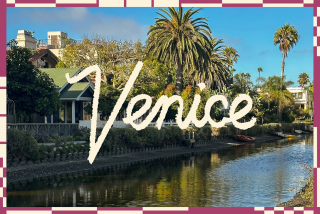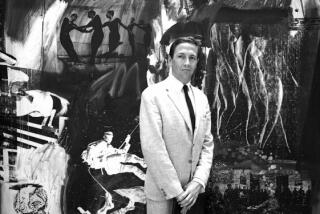Venice on the Hudson
- Share via
VENICE MAY seem an unlikely place to think about globalization. At the right time of year, at the right time of day, the Queen of the Adriatic can seem as if she has been exempted from the 21st century. Not to mention the 19th and the 20th.
Yet precisely because history did leave Venice behind, this is the ideal place to ponder the vast economic changes we are now witnessing. For what befell Venice 500 years ago may well be the imminent fate of its North American counterpart: New York.
Just as the world economy tilted away from Venice around 1500, slowly downgrading it from metropolis to museum, so it could now be tilting away from what was once the greatest entrepot of the Atlantic world.
It’s not just the American investment bankers fretting that London is doing more deals than New York. Far more impressive is the coming shift identified by Princeton University’s Alan Blinder in a recent working paper titled “How Many U.S. Jobs Might Be Offshorable?” Looking closely at which activities are most vulnerable as Asian competition ascends the value chain from manufacturing into services, Blinder estimates that “somewhere between 22% and 29% of all U.S. jobs are or will be potentially offshorable within a decade or two.”
Right now, much more attention gets paid in the U.S. media to illegal immigrants, but most of them compete with the least-skilled Americans: fruit pickers and hotel maids. The new generation of high-skilled but still low-paid Asian graduates can stay home and still compete, not only with computer programmers and telemarketers but also with corporate lawyers and derivatives traders. In short, with New Yorkers.
The more business opportunities arise to the east of New York, the less advantageous its location becomes. And the more New Yorkers’ skills are replicated elsewhere, the less need there is to employ New Yorkers.
Now think what happened to Venice. In 1500, the city was at the zenith of its economic power. The wealth it derived from trade and finance made possible the armies and navies with which the Venetians vanquished their rivals.
Then came Columbus. The discoveries and conquests in the New World after 1492 began a profound reorientation of the world from East to West. As silver and sugar flowed one way across the Atlantic, migrants and slaves the other, new business opportunities arose that favored Amsterdam and London. In effect, the merchants of Venice found their jobs “offshored.”
Yet it was not so much the New World that undercut Venice as the discovery of a new route -- around the Cape of Good Hope -- from the Old World of Europe to the even Older World of Asia. Once Portuguese, Dutch and later British ships could transport spices and silks from the Orient without need of the old overland routes, La Serenissima had lost the three things a successful trading center depends on most: location, location and location.
Is a similar reorientation of the global economy happening today? Yes. The 400 years after Columbus saw a spectacular divergence of economic fortunes -- the West growing wealthy and the East stagnating. New York exemplified the Western triumph. Over the last century, that process has been reversing itself. Ever since Meiji Japan proved that Asians could match Europeans economically and militarily, we have been living through the “great reconvergence.” And in the last 20 years, Asia’s catch-up has dramatically accelerated.
The result has been a perceptible shift in the global balance of power, comparable in its historical significance to the great surge forward achieved by Western Europe and its colonies in the late 18th and 19th centuries.
The question is whether history will oblige us by repeating itself so neatly. Consider the following scenario, which could prematurely cut off the great East-West reconvergence:
Democrats in Congress slap protectionist tariffs on Chinese goods. A defiant President Bush launches airstrikes against Iran, sending oil soaring up to $100 a barrel. The Chinese stock market tanks. The Chinese economy sputters to a halt, causing unemployment and unrest across the country. The more cautious elements in the Communist Party clamp down, but this time they lose control. Such a scenario certainly belongs on the list of “low probability, high impact” events, but definitely not on the list of “wholly impossible, no impact” events.
There is still the chance, then, that New York retains a historic edge over its new Asian rivals -- in political stability. Never mind Shanghai; even London is a much more dangerous place than New York today. Since 9/11, much more has been done to disrupt terrorist networks in the U.S. than in Western Europe.
Venice, as I said, has been lucky in the gentleness of its decline. The next bad thing that happens -- whether in Europe, the Middle East or Asia -- will painfully remind us that the ultimate haven is still the one with the Statue of Liberty at its entrance.
nferguson@latimescolumnists.com
More to Read
Inside the business of entertainment
The Wide Shot brings you news, analysis and insights on everything from streaming wars to production — and what it all means for the future.
You may occasionally receive promotional content from the Los Angeles Times.










